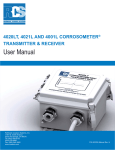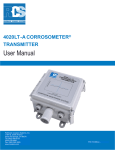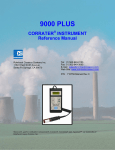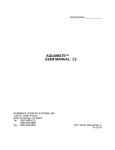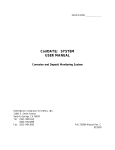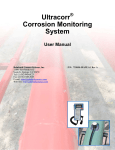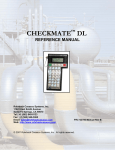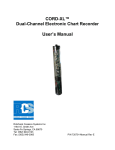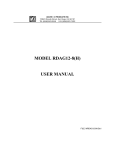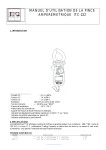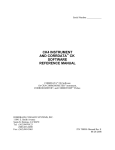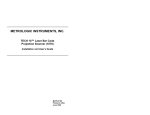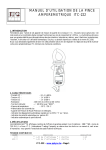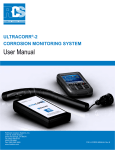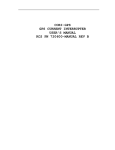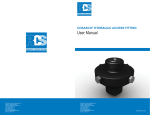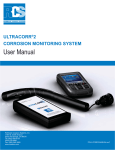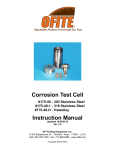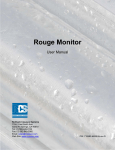Download model 4020lt, 4021l and 4001l corrosometer7 transmitter & receiver
Transcript
Serial Number _______________ MODEL 4020LT, 4021L AND 4001L CORROSOMETER7 TRANSMITTER & RECEIVER USER MANUAL Rohrback Cosasco Systems 11841 E. Smith Avenue Santa Fe Springs, CA 90670 Tel: (1)562-949-0123 Fax: (1)562-949-3065 E-mail: [email protected] Web Site: http://www.rohrbackcosasco.com P/N 402202-Manual Rev.- G 8 2004 Rohrback Cosasco Systems All rights reserved. CORROSOMETER, CORRATER, CORROTEMP, are registered trademarks of Rohrback Cosasco Systems No part of this manual may be reproduced or transmitted in any form or by any means, electronic or mechanical, including photocopying and recording, for any purpose, without the express written permission of Rohrback Cosasco Systems Contents Chapter 1 Introduction .................................................................... 1 Chapter 2 Specification ................................................................... 5 Chapter 3 Installation ...................................................................... 7 Unpacking .................................................................................................... 7 Before Installation......................................................................................... 7 Mechanical Mounting of Transmitter............................................................. 8 Electrical Wiring of Transmitter..................................................................... 9 Zero Calibration Check............................................................................... 12 4021L Receiver Unit ................................................................................... 13 Chapter 4 Operation ...................................................................... 15 Metal Loss From 4-20 mA Signal ............................................................... 15 Corrosion Rate Calculation......................................................................... 16 Probe Spans............................................................................................... 17 Chapter 5 Maintenance.................................................................. 19 Appendix A CORROSOMETER Theory ....................................................... 21 Appendix B Requirements for Intrinsic Safety Operation......................... 27 Appendix C Declaration of Conformity....................................................... 33 Figures and Drawings Figure Page 1.1 4020LT Transmitter Unit............................................................................... 1 1.2 System Configuration Options ...................................................................... 2 1.3 Instrument Type/Probe Type Compatibility................................................... 3 3.1 Types of Cable Connectors and Probes....................................................... 8 3.2 Mounting Dimensions ................................................................................... 9 3.3 Wiring Configurations with Safety Barriers ................................................. 10 3.4 Wiring Configurations without Safety Barriers ............................................ 11 3.5 Location of Zero Calibration Switch ............................................................ 12 3.6 Receiver DIP Switch Settings ..................................................................... 14 4.1 CORROSOMETER7 Probe Types and Spans ........................................... 15 1 Chapter 1 Introduction The Model 4020LT is an intrinsically safe two-wire CORROSOMETER7 Transmitter designed to be directly connected to a plant Distributed Control System (DCS). The 4020LT Transmitter may also be utilized in plants that do not have a DCS system by combining it with a Rohrback Cosasco Systems Model 4021L CORROSOMETER Receiver, to become a stand-alone, single-channel instrument system Model 4001L. Figure 1.1 4020LT Transmitter Unit 2 Transmitter/Receiver Manual The Model 4020LT is easily field mounted and readily applied to the measurement of corrosivity in most process applications. Most wire loop, tube, strip or all welded CORROSOMETER probes may be used with the Model 4020LT Transmitter. WARNING! The Model 4020LT transmitter is not suitable for use with CORROTEMP CORROSOMETER Probes The 4020LT is attached to the probe using the integral five foot extension cable. A single twisted pair cable connects the Transmitter to a standard 4-20mA current loop. The Transmitter controls loop current as a function of metal loss, beginning at 4mA, and ending at 20mA when the CORROSOMETER probe sensing element has been fully corroded. NOTE: The check element of the CORROSOMETER probe is not utilized with Model 4020LT. The general system configurations that may be used are indicated in Figure 1.2. Figure 1.2 System Configuration Options Chapter 1 Introduction 3 The Model 4020LT is compatible with any Rohrback Cosasco CORROSOMETER probe type, but is furnished specifically for each of the three basic probe types from the factory. The compatibility is listed in Figure 1.3. It is not field convertible from one type to another. Transmitter Suffix Probe Type -W- A -TS- B/C -SP- D Element Type Applicable W40, W45, W60, W80 S4, S8, S10, S20, S40, S60, T4, T8 T10, T20, T50 Figure 1.3 Instrument Type/Probe Type Compatibility The Model 4021L Receiver is a line powered display unit which provides a 24VDC supply to power the instrument loop, and provides a readout of metal loss or corrosion rate calculated over the last 48 hours. This system layout is shown in fig. 1.2. The metal loss or corrosion rate display is selectable on the front panel switch. 4 Transmitter/Receiver Manual 5 Chapter 2 Specification Transmitter Model 4021LT — Enclosure NEMA 4X, IP66 — Weight 5 lbs (2.3 Kg) — Dimensions 6.50"H x 8.00"W x 4.25"D (165mm x 203mm x 108mm) — Probe Cable Length 5ft. Standard 50ft. Maximum — Intrinsic Safety rated for USA, Canada, and Europe. For probe element OR transmitter in Class 1 Division 1, or Zone 0 / Zone 1, hazardous area (requires safety barrier): For USA and Canada: Ex ia TEMP CODE T4 Class 1, Division 1 Groups ABC and D when installed in accordance with drawing 081036 For Europe: EEx ia IIC T4 Tamb = -20ºC to +60ºC When installed in accordance with drawing 081036. DEMKO 03 ATEX 0307577X For both probe element AND transmitter in Class 1 Division 2 or Zone 2 (safety barrier not required): For USA and Canada: Class 1, Division 2 groups ABC and D with or without safety barrier with supply maximum voltage of 32 VDC and maximum current 25 mA 6 Transmitter/Receiver Manual — RFI meets European standard IEC 1000-4-3, Test Level 3 over extended frequency range of 20-1000 MHZ — Supply Voltage Range 14-32 VDC at 20 mA — Output 4-20 mA into maximum safe area load of 600 ohms with safety barrier — Resolution " 0.4% — Ambient Temperature Range -18EC (0EF) to +60EC (140EF) Receiver Model 4021L — Panel Mounting — Weight 2 lbs (0.9 kg) — Dimensions 2" x 5.23" x 9.5" (51mm x 133mm x 240mm) — Panel cut out 2" x 4.3" (51mm x 109mm) — Power Supply 115VAC or 240VAC as ordered 50/60Hz 7 Chapter 3 Installation Unpacking Check that the package contains the following items: — — — — Model 4020LT Transmitter 4021L Receiver (with 4001L System) Test probe attached to probe cable Instruction Manual NOTE: All 4020LT system components are carefully tested, inspected and packaged prior to shipment. Before unpacking the instruments, please inspect the packaged materials for shipping damage and retain damaged materials to support any claim against the freight carrier should this become necessary. Before Installation Installation of the 4020LT consists of three separate tasks: — — — Mechanical mounting Electrical wiring Zero (i.e. 4mA) Calibration Check Before proceeding with the installation, several items must be considered. Make sure the Model 4020LT has the correct Rohrback Cosasco Systems type probe connector and the correct transmitter for the probe type you are using (See table in Chapter 1 for confirmation). 8 Transmitter/Receiver Manual Figure 3.1 Types of Cable Connectors and Probes The transmitter should be mounted close enough to the probe to allow the use of the 60-inch extension cable supplied. For mounting of the transmitter or probe in a hazardous area the correct safety barrier and instructions of the intrinsic safety certification must be followed. NOTE: Transmitters are available with longer cables up to a maximum of 50 ft. However, for the best signal to noise performance the cable should be kept as short as practical. Mechanical Mounting of Transmitter The Model 4020LT Transmitter should be located within 48 inches of the CORROSOMETER7 probe to be monitored. The integral extension cable is 60 inches long, but it is preferable to allow a service loop of approximately 12 inches to the probe. Chapter 3 Installation Figure 3.2 Mounting Dimensions Figure 3.2 shows the dimensions and physical layout of the transmitter. Electrical Wiring of Transmitter If both the probe and transmitter are located in a non-electrically hazardous area, the transmitter may be connected as any other typical two wire transmitter. A DC supply of typically 24 VDC is required to power the 4-20mA loop. The transmitter requires between 14 and 32 VDC at the transmitter for correct operation. NOTE: If the environment for both the probe element in the process stream, AND the transmitter are classified as Class 1, Division 2 or Zone 2 the transmitter may be used without a safety barrier (see intrinsic safety certifications). If either probe element OR transmitter are in a Class 1, Division 1 or Zone 0 / Zone 1 a safety barrier must be used. 9 10 Transmitter/Receiver Manual Figure 3.3 Wiring Configurations With Safety Barriers Chapter 3 Installation Figure 3.4 Wiring Configurations Without Safety Barriers 11 12 Transmitter/Receiver Manual Zero Calibration Check For location of the switch to check the zero calibration (4.0 mA) of the transmitter see Figure 3.5. Figure 3.5 Location of Zero Calibration Switch Normally, this zero calibration may be omitted since any slight zero shift is of little consequence since it is the change in metal loss that is important, which is not affected by the starting value. However, if the zero is thought to be significantly off the correct value, proceed as follows. Temporarily remove the plus lead from the 4-20mA loop connections to the transmitter. Install a suitable current meter, observing meter polarity between the wire and the plus terminal. Set the calibrate switch to the calibrate position. Power up the loop current source and observe the current meter. Adjust R207 on the Transmitter board and adjust for 4mA of indicated current (ccw is the minimum current). Power down the loop current source, and return the switch to the run position. When the calibrate switch is returned to the run position (and loop current is on) it will take up to a maximum of three minutes for the Transmitter output current to settle to its probe driven value. Remove the current meter and reconnect the plus current loop lead to the plus terminal of the 4-20mA loop connectors. Chapter 3 Installation 13 The current loop may be energized and the 4020LT CORROSOMETER7 is now on line. It is unnecessary to "range" the current loop from 4-20mA during calibration, and there are no user adjustments for this purpose. It is only necessary to set the 4mA value with this type of CORROSOMETER system. However, there is supplied with the transmitter a test probe that provides an upscale reading that is primarily intended as a Ago-nogo@ test for the instrument to check between an instrument problem and a probe problem (see Chapter 5 - Maintenance). The value printed on the test probe in mA may be used to check the loop current and the equivalent displayed output in the DCS system or on the 4021 Receiver. 4021L Receiver Unit When the system is used with the Model 4021L receiver (designated Model 4001L as a complete system) the receiver unit provides the 24VDC to power the loop and provides a panel display of metal loss or corrosion rate based on the last 48 hours of data. The system connection details are shown in figure 3.4. Normally the system is supplied with the Model 4021L receiver unit set to ranges corresponding to the probe with which it will be used. This will be indicated on the outside of the unit. If this ranging needs to be hanged, remove the side panel and reset the DIP switches as indicated in the table below. WARNING! Take particular note that as these switches are designated by element thickness NOT element span. Example: a W40 probe has 40 mil thickness for this setting purpose, although its span is 10 mils. The DIP switch settings are as follows: 14 Transmitter/Receiver Manual Probe Thickness (mils) Element DIP Switches 9 Off On 1 2 3 4 5 6 0.25 9 9 9 9 0.5 9 9 9 1 9 9 9 2 9 9 9 9 9 9 9 Probe Type 5 6 Wire (A) 9 Tube Loop / Flush (B) 9 9 Strip Loop 8 Cylindrical (D) 9 4 S4*,T4 5 8 S8*,T8 9 9 10 S10*,T10 9 20 S20*,T20 9 9 9 9 9 30 40 S40*,W40 9 9 45 W45 9 50 T50 9 9 9 9 60 80 W80 100 Display Units 7 8 7 8 Micrometers 9 mils Rate / Metal Loss Penetration 9 Figure 3.6 Receiver DIP Switch Settings 15 Chapter 4 Operation The output from a model 4020LT transmitter is a 4-20mA signal that corresponds linearly to the range of zero to the probe span. WARNING! This linear output is different from the earlier model 4020 transmitter, which had a non-linear characteristic. If using the 4020LT to replace a model 4020 the conversion formula for the corrosion data must be modified. Metal Loss From 4-20mA Signal To convert the 4-20mA signal into metal loss the conversion formula is as follows: Metal Loss in mils = Metal Loss in mm = Metal loss in µm = {I L - 4} * Probe Span (mils) 16 {I L - 4} * Probe Span (mils) * 0.0254 16 {I L - 4} * Probe Span (mils) * 25.4 16 It is advisable to record the metal loss typically every five minutes and generate a graph of metal loss against time. Visual display of the data is very useful to check general trends and the significance of any signal noise. It is also helpful in determining the filter factor for the corrosion rate algorithm as detailed in the next section. 16 Transmitter/Receiver Manual Corrosion Rate Calculation The Model 4021L receiver unit operates on a simplified algorithm that calculates corrosion rate every 6 hours. The rate is computed from the metal loss change over the previous 48 hours. For Distributed Control Systems (DCS) we recommend a corrosion rate algorithm based on linear regression (the best straight line), with an adjustable filter factor. The adjustable filter factor is obtained by varying the number (or time period) of readings (m in the formula) over which the liner regression is applied. Readings are best taken every five minutes. The time period over which the data should be computed is 1 to 5 days, with the ability to adjust this, preferably on an individual probe channel basis. Slope = Corrosion rate = ∑ y i ( xi - µ ) 2 ∑( xi - µ ) (1) where, µ= ∑ xi m (2) and, y = value of metal loss numbers, corresponding to x time base values x = the time base values m = the number of points used for the regression Depending on the units chosen for x and y, the corrosion rate may need to be converted to the rate units required. As an example if y is in units of mils, as determined from the formula in the Metal Loss from 4-20 mA signal section, and H is in units of days from some nominal origin. Using a time base of 3 days of data for calculation of rate (i.e. 3 x 24 x 12 = 864 data points) the corrosion rate from equations (1) and (2) would be in units of mils/day. This could normally be converted to mils/year by multiplying by 365. Chapter 4 Operation 17 In setting up the algorithm the time period of 3 days in the example should be adjustable from 1 to 5 days to provide filtering as necessary to minimize noise yet give adequate sensitivity to upsets. The shorter the time period, the more sensitive but noisier will be the rate calculation. The longer the time period, the less sensitive but quieter will be the rate calculation. Probe Spans The following table indicates the probe spans for the various probe types available. SPAN CORROSOMETER PROBE ELEMENT TYPE mils mm Fm Strip Loop S4 C 1.0 0.025 25 Flush Element S4* Atmospheric Element S4* Strip Loop S8 Tube Loop T4 B D C B 2.0 0.051 51 Flush Element S8* Atmospheric Element S8* Tube Loop T8 B D B 4.0 0.102 102 Flush Element S10* Cylindrical Element T10 B D 5.0 0.127 127 Flush Element S20* Cylindrical Element T20 Wire Loop Element W40 B D A 10.0 0.254 254 Wire Loop Element W45 A 11.25 0.285 286 Flush Element S40* Wire Loop Element W80 B A 20.0 0.508 508 Cylindrical Element T50 D 25.0 0.635 635 Figure 4.1 CORROSOMETER Probe Types and Spans When using the Model 4021L receiver unit the probe thickness rather than probe span must be set with DIP switches (see section on 4021L Receiver Unit in Chapter 3). 18 Transmitter/Receiver Manual 19 Chapter 5 Maintenance The Model 4020LT Transmitter should require little maintenance. Normal probe replacement is required in order to maintain continuous corrosion monitoring at a site. All probes have a certain life based on their geometry and amount of corrosion they are exposed to. A probe replacement schedule should be established with a criterion such as 7/8 of probe life (875 span divisions) to time change out. As a reminder, proper probe selection should be based on closely matching probe span to mpy corrosion rate for optimum instrument accuracy. During probe replacement, all connections, such as the connectors at the probe, should be environmentally protected and checked for good electrical conduction. Under normal conditions the Transmitter should not require recalibration when replacing identical probes. It is recommended as a good procedure that the current loop power source be powered down during probe change out. WARNING! For reasons of maintaining the intrinsic safety certifications it is important that any repairs be carried out by RCS or its authorized agent to maintain the certification of the instrument. The Model 4021L Receiver requires no maintenance. If a problem is suspected with the probe or transmitter, use the test probe provided with the transmitter to test the loop. The test probe is marked with the loop current in mA that this should provide in the 4-20 mA loop. This signal may be converted to check the display on the receiver if applicable. Metal loss display = ( Test probe mA - 4 ) x Probe SPAN (mils) 16 20 Transmitter/Receiver Manual 21 Appendix A CORROSOMETER Theory CORROSOMETER Systems are based on the electrical resistance method of corrosion monitoring pioneered by Rohrback in the 1950's and 1960's. CORROSOMETER probes are basically "electrical coupons." They determine the loss of metal from the probe by measuring the change in its resistance. Because of the very low resistances involved, very sensitive monitoring circuits are used in CORROSOMETER instruments to measure the change in probe resistance compared to a protected reference element resistance series-connected to the corroding measurement element. A "check" element is also included and is protected from the process along with the reference element. The ratio of check to reference resistance should remain constant. If it doesn't, this indicates that degradation of the reference element may be occurring and that metal loss readings obtained from the probe are questionable. A simplified diagram of a typical electrical resistance monitoring circuit is shown in Figure 1. FIGURE 1 22 Transmitter/Receiver Manual As with coupons, CORROSOMETER probes must be allowed to corrode for a period of time before accurate corrosion rate measurements can be made. The actual length of time required depends upon the corrosion rate--the higher the rate, the shorter the time required, and vice-versa. CORROSOMETER probes are available in a variety of styles and with useful probe life ("span") ranging from 2-25 mils, in styles commonly used in process piping systems. Instrumentation to measure electrical resistance probes divides the probe span into l000 "divisions." A probe with a 2 mil span is therefore theoretically capable of measuring thickness changes of 0.002 mils. In practice, however, we recommend that a change in indicated metal loss of l0 divisions be required before the data is used to calculate corrosion rate. Indications of an upward or downward trend can be obtained with as little as a 4-division change, but care must be exercised in interpreting such small changes because other factors (e.g. temperature changes) can also be responsible. The actual time required to produce meaningful corrosion rate information with common probe spans at different corrosion rates is shown in Figure 2 and summarized in Table 1. 23 Appendix A FIGURE 2 Corrosion Rate (mpy) Probe Span (mils) 2 4 5 10 20 25 0.1 73 days 5 months 6 months 12 months 24 months 30 months 0.5 15 days 29 days 37 days 73 days 5 months 6 months 1.0 7 days 15 days 18 days 36 days 73 days 3 months 5.0 35 hours 3 days 4 days 7 days 15 days 18 days 10 18 hours 35 hours 2 days 4 days 7 days 9 days 25 7 hours 14 hours 18 hours 35 hours 3 days 4 days 50 4 hours 7 hours 9 hours 18 hours 35 hours 2 days 75 140 mins 5 hours 6 hours 12 hours 23 hours 29 hours 100 105 mins 4 hours 5 hours 9 hours 18 hours 22 hours TABLE 1 Elapsed Time* To: Corrosion Rate* with 10 mil Span Probe Early Trend Indication (4 Div.) Meaningful Rate Data (10 Div.) End of Useful Probe Life (1000 Div.) 1.6 hours 4.0 hours 17 days 220 mpy (5.6 mm/y) 4.0 hours 10.0 hours 1.4 months 88 mpy (2.2 mm/y) 9.6 hours 1 day 3.3 months 37 mpy (0.94 mm/y) 18.0 hours 1.8 days 6.0 months 20 mpy (0.51 mm/y) 1.1 days 2.7 days 9.0 months 13 mpy (0.33 mm/y) 1.5 days 3.7 days 12.0 months 10 mpy (0.25 mm/y) 1.8 days 4.6 days 15.0 months 8 mpy (0.20 mm/y) 2.2 days 5.5 days 18.0 months 6.7 mpy (0.17 mm/y) 2.9 days 7.3 days 24.0 months 5 mpy (0.13 mm/y) * All data shown to two significant digits only. TABLE 2 From Table 1, it would appear desirable to always choose probes with the lowest span 24 Transmitter/Receiver Manual available in order to get the greatest sensitivity. However, the more sensitive the probe, the faster the entire probe span will corrode away and require a new probe to be installed. Table 2 illustrates this relationship. It is our experience that the objectives of most monitoring programs can be achieved cost-efficiently by selecting CORROSOMETER probes which will reach the end of their useful life in 6 - 9 months at the expected corrosion rate. Unlike a monthly coupon replacement program, this electrical resistance probe will continuously produce data that verifies that the average corrosion rate over the previous 2-3 days is still at the originally-expected (design) rate. If the corrosion rate increases to twice the design rate, meaningful data to permit the new rate to be calculated will be available in a day and a half. Conversely, if the actual corrosion rate is below design, a longer period is required before meaningful data are available to calculate the new rate. CORROSOMETER probe elements are available in a variety of styles. A selection of the available styles is shown in Figure 3. Wire, tube, and strip-loop styles all have a loop of metal exposed to the process. The loop protrudes from the end of the probe body through either a hermetic glass seal or a Teflon/ceramic, Teflon/epoxy or epoxy seal/packing system. Choice of materials is dependent upon stream composition, process conditions and performance requirements. Cylindrical elements utilize specially-made, thin-wall tubing as the measurement element. Cylindrical probes are generally "all-metal;" i.e., there is no other material exposed to the process. There are, however, also some cylindrical probes available which join the probe body at a hermetic glass seal. A variety of flush-mounted probes are also available; so-called because the measuring element is mounted parallel to the flow stream, flush with the inside pipe wall. FIGURE 3 Appendix A 25 CORROSOMETER monitoring systems can be applied to all processes. However, some types of CORROSOMETER probes are better suited to the requirements of particular applications than others. Different styles of CORROSOMETER probes are affected to different degrees by pitting attack. Figure 4 shows the results of pitting attack on a wire loop probe. Although the remaining wire thickness shows that only 30% or so of the probe span has been consumed, the probe is obviously out of service. Cylindrical elements on the other hand, are affected to a much lesser degree by pitting because of the much larger circumference of the measuring element. Wire loop and tube loop elements also have a tendency to be electrically shorted by a bridge of iron sulfide corrosion product. This is especially prevalent in low-velocity streams over an extended period. The effect of such bridging is to reduce the measured metal loss of the probe, creating a misleadingly low corrosion rate. Cylindrical probes demonstrate more resistance to iron-sulfide bridging due to their construction and lower inherent resistance per unit length, thus minimizing the effect of the shunt resistance. Where pitting or substantial FexSy deposition are expected to be problems, cylindrical probes should be chosen wherever possible over loop-style probes. FIGURE 4 Most cylindrical probes are of all-welded construction in order to eliminate the need for sealing metal elements to non-metallic glass, epoxy or ceramic. This all-welded construction gives the probe superior resistance to leaking. Probes with higher temperature ratings can also be constructed in the all-welded style. A drawback to the all-welded style is that the element is electrically connected to the pipe wall which can, in certain conditions, interfere with the corrosion reaction on the probe. Also, because cylindrical probes are welded, in some conditions preferential corrosion can occur in the heat-affected zones near the weld. Flush probe elements are thin, flat metal sections embedded in epoxy or a hermetic 26 Transmitter/Receiver Manual glass seal inside a metal probe body. Flush probes also experience certain characteristic problems, most notably: lack of adhesion of the metal element to the epoxy, cracking of glass seals due to differential expansion and erosion of the epoxy or glass due to high velocities, abrasive materials in the flowstream or both. Flush CORROSOMETER probes mounted on the bottom of the line have been shown to provide good results in a sour gas gathering system. Because the measurement element is part of the primary pressure seal, and because it's designed to corrode, CORROSOMETER probes have a reduced resistance to leaking after prolonged exposure. Once the measurement element has corroded through, the internals of the probe body are exposed to the process fluid. Although materials are chosen in part for their strength and lack of permeability, it is our experience that process fluids will permeate throughout the probe packing material. For this reason, quality probes are constructed of corrosion-resistant body materials and include a secondary pressure seal, often consisting of a hermetic glass-sealed connector. Other back-up seals are utilized in special cases, especially where process fluids will attack glass (e.g. hydrofluoric acid service). Please contact the factory if you have any questions about the compatibility of probe materials with your application. The reference and check elements are protected from the process to which the measurement element is directly exposed. Temperature changes in the process will, therefore, affect the measure element before the reference and check elements. Because of the very low resistances involved, these changes can significantly affect the metal loss readings. CORROSOMETER probes incorporate special design features to minimize the thermal resistance of the materials insulating the reference and check elements from the process. It should also be noted that cylindrical probes are inherently better able to react to temperature changes due to location of the reference and check elements concentrically inside the measure element. 27 Appendix B Requirements for Intrinsic Safety Operation To meet the requirements of the certifying authorities for the intrinsic safety certifications under which the equipment is operated, it is important that the requirements of the certifications documents and installation practices are followed. The following certification documents provide this information. WARNING! The transmitter has certifications for use with and without a safety barrier. In general, the process stream into which the CORROSOMETER probe is installed will determine if a safety barrier is required. If this process stream is classified as Class 1 Division 1, or Zone 0 or Zone 1 by the jurisdiction of the applicable authority, then a safety barrier MUST BE USED. Alternatively, if the process stream is classified as Class 1 Division 2, or Zone 2, then the safety barrier NEED NOT BE USED. 28 29 30 31 32 33 Appendix C Manufacturer=s Declaration of Conformity We the manufacturer hereby declare that this product: PRODUCT NAME: Loop Powered CORROSOMETER Transmitter MODEL: A4020LT@ is in full compliance with all applicable EU Product Directives and required standards as noted below: EMC DIRECTIVE 89/336/EEC PRODUCT STANDARDS: EN55022:1994 Radiated Emissions - EN 55011:1991, Group 1, Class A Immunity (Heavy Industrial) - EN 50082-2: 1995 Electrosatatic Discharge - EN 61000-4-2: 1995 Radiated EM Field - ENV 50140: 1994 Electrical Fast Transient - EN 61000-4-4 :1995 Conducted Immunity - ENV 50141 :1993 PLACE AND DATE OF ISSUE: April 9, 1997 Rohrback Cosasco Systems Santa Fe Springs, California USA AUTHORIZED SIGNATURE: ______________________ Ronald J. Martinez Director of Quality Assurance





































